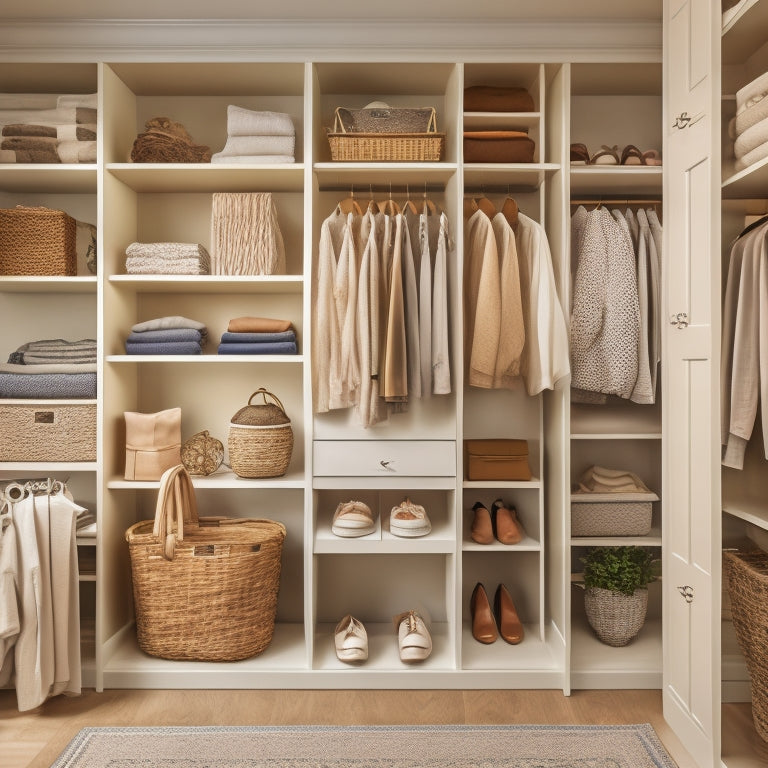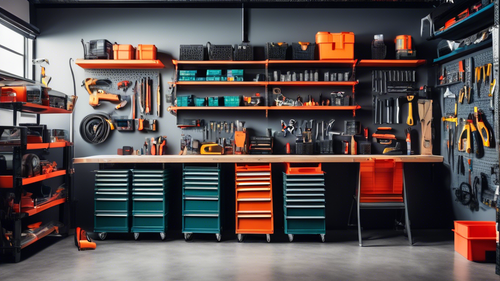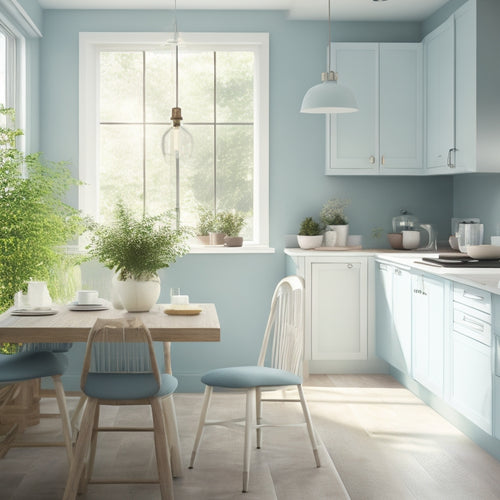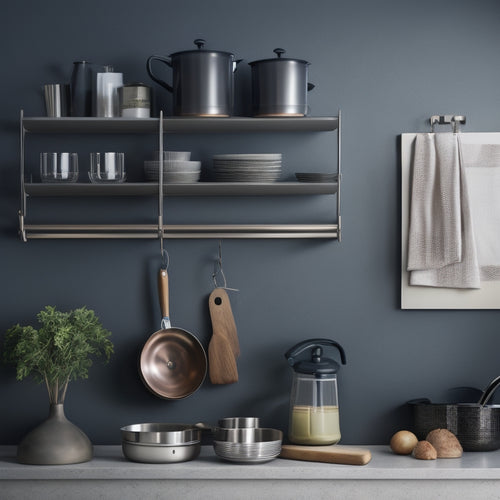
Mastering Closet Organization: A Step-by-Step Guide
Share
You're about to transform your closet from a cluttered nightmare into a serene oasis that sparks joy and saves you time. Start by evaluating your closet space, noting measurements, and understanding the layout for optimization. Then, declutter and purge items, categorizing belongings for intentional decisions. Measure and map your closet, envisioning storage solutions and identifying prime storage areas. From there, choose storage systems that maximize space, and utilize vertical storage options. Next, organize clothing and accessories, implementing a maintenance routine to keep your closet organized. Now, get ready to tailor your closet to your style and needs.
Key Takeaways
• Assess your closet space by measuring floor space, shelves, and rods to optimize layout and identify storage solutions.
• Declutter and purge items by categorizing belongings, implementing seasonal rotation, and using decluttering methods to remove unnecessary items.
• Choose a storage system that maximizes space, considering dimensions, layout, and item types, and opt for containers and shelving styles that suit your needs.
• Utilize hidden storage areas, such as floor space beneath hanging clothes, and maximize vertical storage with shelves, rods, and over-the-door storage.
• Implement a maintenance routine by putting away items after use, dusting shelves, and removing unwanted items regularly to maintain your organized closet.
Assessing Your Closet Space
Take stock of your closet's dimensions, noting the exact measurements of the floor space, shelves, and rods to understand the layout and identify potential areas for optimization. Don't worry, it's not as painful as it sounds! Grab a tape measure and get to work.
Knowing your closet's dimensions will help you determine the most effective space utilization strategies. You'll be amazed at how a little math can spark some serious organization inspiration.
As you assess your closet's layout, think about your storage solutions. Do you need more shelves for folded items or rods for hanging clothes? Are there any awkward nooks or crannies that could be repurposed? Take note of any areas that are currently underutilized or inefficient.
With a clear understanding of your closet's space, you can start brainstorming innovative organization tips to maximize every inch. By doing so, you'll be well on your way to creating a closet that's both functional and fabulous.
Decluttering and Purging Strategies
Now that you've assessed your closet space, it's time to tackle the often-daunting task of decluttering and purging.
You'll need to sort through your belongings, separating items you want to keep from those you can live without. By doing so, you'll be able to identify what's truly essential and what's merely taking up valuable space.
Sort and Separate Items
By categorizing your closet contents into three piles - keep, donate/sell, and discard - you'll be able to visualize your belongings and make intentional decisions about what stays and what goes. This is where the magic begins! Take everything out of your closet and sort items into these three piles. Be honest with yourself - when was the last time you wore that sweater?
| Keep | Donate/Sell | Discard |
|---|---|---|
| Favorite pieces in good condition | Gently used items that can benefit others | Stained, torn, or outdated items |
| Items that fit and make you feel great | Items that are still in style but no longer fit | Items that are no longer relevant to your lifestyle |
| Pieces that can be color coordinated | Items that can be repurposed or upcycled | Items that are broken or beyond repair |
As you sort, consider implementing a seasonal rotation to keep your closet fresh and current. Store out-of-season items in labeled bins or containers to free up space and reduce clutter. Remember, the goal is to create a closet that sparks joy and makes your daily routine easier.
Purge the Unnecessary
You've made significant progress by sorting your closet contents into three piles, and now it's time to get ruthless and purge the unnecessary items that are holding you back from achieving your ideal closet space. It's time to adopt a minimalist approach and focus on your closet essentials – the items that bring you joy or serve a practical purpose.
Be honest with yourself, if you haven't worn that dress in two years, it's probably safe to let it go.
As you sift through your 'maybe' pile, ask yourself if each item sparks joy or if it's just taking up valuable real estate. If it's the latter, it's time to say goodbye. Add it to your donation pile or consider selling it to fund your new, organized closet.
Don't worry, decluttering methods like the 'hanger trick' can help you identify which items are truly worth keeping. Remember, the goal is to create a space that makes you feel calm, not cluttered.
Measuring and Mapping Your Closet
Now that you've purged your closet, it's time to assess the space you're working with. Take out your tape measure and record the length, width, and height of your closet, including any obstructions like windows or columns.
Closet Dimensions Matter
Take precise measurements of your closet's length, width, and any obstructions to create an accurate map of the space, which will serve as the foundation for your organization plan. Don't eyeball it – grab a tape measure and get to work! Record every nook and cranny, including the location of windows, doors, shelves, and any other features that might impact your closet layout.
With your measurements in hand, start thinking about your storage solutions. Consider the types of items you need to store, from shoes to shirts to accessories. Envision how you want to use the space – do you need a section for long-hanging items, or a shelf for folded clothes? Think about the flow of your closet, too. Where do you want to place your most frequently used items?
Mapping Storage Spaces
With your closet's dimensions in mind, identify the areas that will serve as prime real estate for your storage solutions, focusing on the spaces that will house your most essential items. Think of it as a game of closet Tetris – you need to strategically fit your storage pieces together to maximize space.
Next, visualize your shelving options and where they'll go. Will you opt for adjustable shelves or fixed ones? Consider the items you'll be storing and the space they require. Drawer dividers will also come in handy for keeping folded items organized and easy to find.
Don't forget about hanging solutions! Decide where you'll install rods, hooks, or shelves for your clothes, bags, and accessories.
Ultimately, think about bin organization for your shoes, accessories, or linens. Labeling your bins will help you (and your future self) quickly locate what you need.
Choosing the Right Storage Systems
You'll need to assess your closet's unique dimensions and storage needs to select the perfect storage system that maximizes space and keeps your belongings organized. After all, you don't want to end up with a system that's as useful as a square peg in a round hole!
Consider your closet layout and the types of items you need to store. Do you have a lot of long, hanging items or a plethora of shoes? You'll want storage solutions that cater to these specific needs.
When it comes to container options, think about the types of items you'll be storing. Clear bins are great for storing items you need to see, like sweaters or accessories, while opaque bins are better for items you don't need to access frequently, like out-of-season clothing.
Shelving styles also play an integral role in your storage system. Fixed shelves are great for storing items of a similar size, while adjustable shelves offer more flexibility.
Maximizing Vertical Storage Space
How can you make the most of your closet's vertical space, often the most underutilized area in the room? By maximizing your closet's vertical storage space, you'll be amazed at how much more you can fit in!
Here are some clever ways to do just that:
-
Install vertical shelving to store folded items like sweaters, jeans, or blankets. You can also use stackable bins or baskets to store accessories or linens.
-
Take advantage of hanging space by using double rods or shelves with hanging rods underneath. This is perfect for storing out-of-season clothes or bulky items like winter coats.
-
Utilize the back of your closet door by adding over-the-door shoe racks or hooks for hanging belts, scarves, or bags.
-
Consider investing in floor-to-ceiling shelves or storage units that go all the way up to the ceiling. This will help you make the most of your closet's vertical space.
-
Don't forget about the space above your closet rod – use it to store infrequently used items like luggage or storage bins.
Utilizing Hidden Storage Areas
Your closet has hidden gems waiting to be uncovered, and by tapping into these secret storage areas, you can stash away even more items out of sight. From the back of the door to the floor beneath your feet, there are creative solutions waiting to be discovered.
Take advantage of over-the-door storage racks, hooks, or baskets to hang belts, scarves, or bags, freeing up precious shelf space.
Look down and explore the floor – is there room for a storage ottoman or a hidden compartment? You can even utilize the space under your bed for out-of-season clothing or linens.
Don't forget about the walls! Install shelves, hooks, or a pegboard to maximize space optimization. The key is to think outside the box (or closet) and get creative with your storage solutions.
Organizing Clothing and Accessories
Now that you've maximized your closet's hidden storage, it's time to tackle the fun part: organizing your clothing and accessories.
You'll start by categorizing your clothes into manageable groups, making it easier to find what you need and identify what you can purge.
Next, you'll learn how to store your accessories in a way that keeps them organized, visible, and easy to access.
Sorting Clothing Categories
You'll need to categorize your clothing items into groups, such as tops, bottoms, dresses, outerwear, and accessories, to create a solid foundation for your closet organization system. This might seem like a challenging task, but trust us, it's an essential step in achieving closet nirvana.
As you sort, remember to keep these key considerations in mind:
- Color coordinating: Group similar shades together to create a visually pleasing and easy-to-navigate closet.
- Seasonal rotation: Store out-of-season clothes separately to free up space and reduce clutter.
- Consider the frequency of wear: separate daily essentials from special occasion items.
- Think about the type of occasion: group work clothes, formal wear, and casual attire separately.
- Don't forget about the little things: categorize socks, underwear, and other essentials by type and color.
Storing Accessories Efficiently
Storing Accessories Efficiently
Organize your accessories into categories, such as hats, scarves, belts, and bags, to guarantee everything has a designated home and is easily accessible. This way, you'll avoid the frustrating 'where did I put that?' moments.
When it comes to storing accessories, consider the Hanging vs. Folding debate. For items like hats and bags, hanging them on hooks or a pegboard keeps them visible and saves space. For smaller items like scarves and belts, folding them neatly and storing them in a drawer with dividers is a great option.
Drawer dividers will keep your accessories organized and prevent them from getting jumbled together. You can also repurpose shoe racks to store bags, hats, or even jewelry. Accessory display racks can be a great way to showcase your favorite pieces while keeping them organized.
Implementing a Maintenance Routine
Every week, set aside 10-15 minutes to maintain your newly organized closet, ensuring it stays clutter-free and functional. You've worked hard to get your closet in tip-top shape, and with a little regular TLC, it'll stay that way. Creating a maintenance schedule is key to preventing clutter from building up again.
Here are some habits to establish for regular upkeep:
-
Hang up clothes as soon as they're dry to prevent wrinkles and creases
-
Put away items after use to maintain a sense of tidiness
-
Dust shelves and vacuum the floor to keep your closet clean and dust-free
-
Go through your closet every 3-4 months to remove items that no longer fit or suit your style
-
Take inventory of your storage containers and refill or replace them as needed
Customizing Your Closet Design
Now that your closet is organized and you've established a maintenance routine, it's time to think about customizing your closet design to fit your personal style and meet your specific needs. This is where the fun begins! You get to make your closet a reflection of you, and who doesn't love that?
First, consider color coordination. Choose a palette that makes you happy and stick to it. This will create a visually pleasing space that's easy on the eyes. Plus, it'll make getting dressed in the morning a breeze.
Next, think about seasonal rotation. Store out-of-season clothes in labeled bins or containers to free up space and reduce clutter. This will also help you avoid decision fatigue when getting dressed – no more standing in front of your closet wondering what to wear.
Overcoming Common Organizing Challenges
As you work to maintain your newly organized closet, you'll likely encounter a few common obstacles that can derail your best intentions. Don't worry, it's normal! The key is to anticipate these challenges and have a plan to overcome them.
Here are a few common hurdles you might face, along with some tips to help you jump over them:
-
Clutter creep: You've organized your closet, but somehow it's still getting cluttered. Solution: Schedule regular tidying sessions to keep things in check.
-
Lack of space: You've run out of room for new purchases. Solution: Invest in space-saving solutions like shelves, bins, and double rods to maximize your closet layout.
-
Functional design flaws: Your closet design isn't quite functional. Solution: Rethink your layout to prioritize storage hacks like baskets, bins, and hooks.
-
Seasonal storage woes: You're not sure what to do with out-of-season clothes. Solution: Consider storing them in underbed storage or vacuum-sealed bags to free up space.
-
Maintenance motivation: You're struggling to keep your closet organized. Solution: Make it a habit by setting aside a few minutes each week to maintain your space.
Frequently Asked Questions
How Do I Keep My Closet Organized During a Move or Renovation?
"Chaos or calm, you get to choose! During a move or renovation, you're not doomed to a disorganized closet. Use packing tips like categorizing and labeling boxes, and opt for temporary closet storage solutions to keep your sanity intact."
Can I DIY My Own Custom Closet Storage Solutions?
"Yep, you can DIY custom closet storage solutions! Create custom shelves, hanging rods, and storage bins, and add clothing dividers, drawer inserts, and space-saving hangers to maximize your closet's potential - get creative and make it your own!"
How Often Should I Reorganize and Update My Closet System?
You should reorganize and update your closet system every 3-6 months with seasonal updates, and perform a thorough closet audit with decluttering every 6-12 months to keep your space fresh and functional.
Are There Any Eco-Friendly Closet Organization Product Options Available?
You're looking for eco-friendly closet organization products that don't harm the planet! Luckily, you'll find sustainable options and environmentally friendly choices, like recycled shelving, bamboo bins, and repurposed storage containers, to keep your closet organized and guilt-free.
How Can I Involve My Family Members in Maintaining Our Closet Space?
Imagine you're the captain of a ship, and your closet is the treasure chest. You can't sail solo; involve your family members as crewmates, assigning shared responsibilities to maintain the treasure trove, making organization tips a fun, collaborative adventure!
Related Posts
-

Pro-Level Garage Organization
Garage Organization: A Pro's Perspective Your Garage: A Sanctuary or a Storage Nightmare? Picture this: a garage th...
-

Tiny Kitchen Decor Ideas to Boost Space
You can unveil the potential of your tiny kitchen by implementing clever decor ideas that enhance space and efficienc...
-

Corner Kitchen Utensil Storage Solutions
You're likely wasting up to one-third of your cabinet space in corner areas, but with the right storage solutions, yo...


